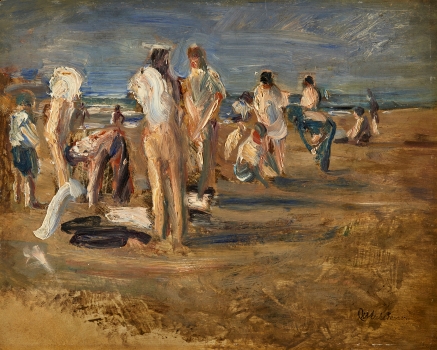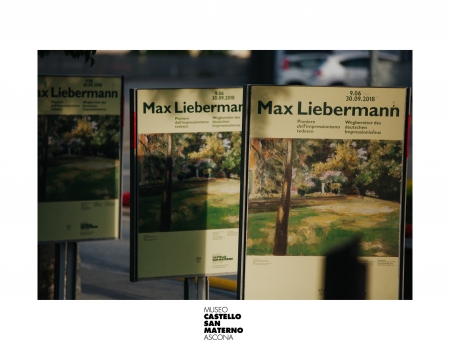 Once again, a work by Max Liebermann from the Kunst der Westküste Collection will be journeying outside the museum. Several of the artist’s paintings have already been loaned to the Gemeentemuseum in The Hague (the exhibition Max Liebermann – Impressions of Summer will be on display until 24 June 2018, as reported by the Insel-Bote), and now the oil study Bathing Youths, created around 1899, is being brought to the Swiss town of Ascona. It will be shown there from 8 June 2018, together with other works by Liebermann, at the solo exhibition Max Liebermann – Pioneer of German Impressionism at the Museo Castello San Materno.
Once again, a work by Max Liebermann from the Kunst der Westküste Collection will be journeying outside the museum. Several of the artist’s paintings have already been loaned to the Gemeentemuseum in The Hague (the exhibition Max Liebermann – Impressions of Summer will be on display until 24 June 2018, as reported by the Insel-Bote), and now the oil study Bathing Youths, created around 1899, is being brought to the Swiss town of Ascona. It will be shown there from 8 June 2018, together with other works by Liebermann, at the solo exhibition Max Liebermann – Pioneer of German Impressionism at the Museo Castello San Materno.
The museum was opened in 2014 and houses the collection of the entrepreneurial couple Kurt and Barbara Alten. Their collected works had previously been incorporated into the Kulturstiftung Kurt und Barbara Alten and were to be made accessible to the public. The artworks of this small but fine collection are primarily by the Worpswede painters Otto Modersohn, Paula Modersohn-Becker and Fritz Overbeck, but it additionally features works by the Expressionists Christian Rohlfs, Erich Heckel, Emil Nolde and Ernst Ludwig Kirchner. Finally, Max Liebermann is also represented by several paintings. It thus seems only logical to present his art to a southern Swiss audience in Ticino within the framework of a solo exhibition. After all, the Berlin painter and his family went to Switzerland on holiday multiple times, several important collectors of his art lived there and he is considered one of the most important representatives of German Impressionism. The works he painted and drew on the beaches of the Dutch resort towns of Zandvoort, Katwijk, Noordwijk and Scheveningen particularly display his skill in spontaneously capturing open-air scenes. The rapid brushstroke which he adopted from the painting of the French Impressionists and used to place the figures on the canvas or paper also assisted him in this.
The Bathing Youths, which are painted with a heightened degree of abstraction, demonstrate this link in an exemplary manner. With just a few confident strokes on this small sheet of cardboard, Liebermann has realised a scene that was popular among the Impressionists. He has created a sense of the pleasure of bathing on a fine summer day, with the young men refreshing themselves in the cool waters of the sea. Because Liebermann also repeatedly worked directly at the beach, it is very probable that this oil study was also carried out immediately at this location. At the same time, it forms part of a series of numerous variations in which the artist depicted the subject of Bathing Youths. Other motifs created over the course of many years during the summer months spent along the western coast of the Netherlands depict riders on the beach or also tennis-playing summer tourists who could afford holidays of this kind in 1900.
In contrast to these works, however, in his Bathing Youths Liebermann has depicted only local boys from the surrounding villages, who were able to casually enjoy their bathing away from the fashionable seaside resorts. At that time the bourgeois public was still entering the water wearing long bathing costumes and by means of special bathing machines carried out into the sea by horses. The wish to take off their clothes and enjoy the waves in the nude seemed unthinkable within the strict system of social norms dominant at that time.
The oil study, which entered the Kunst der Westküste Collection in 2015, had long been unknown. Together with the painting of the same name painted by Liebermann in 1902 and other works featuring the same motif in the collection of the Alkersum museum, it provides a vivid presentation of this theme on Föhr. The fact the work is now being exhibited in Ascona, together with loans from other institutions as well as that collection’s own works, additionally demonstrates this little study’s importance within the artist’s oeuvre. As stated in Museo Castello San Marteno’s loan request: “with select works – paintings as well as works on paper” – Liebermann’s “artistic development from his early paintings to his late work” is to be presented. The Museum Kunst der Westküste is very glad to have supported this project with a loan, and we wish our colleagues in Ascona a highly successful exhibition.

Exhibition:
Max Liebermann – Pioneer of German Impressionism
8 June to 30 September 2018
Museo Castello San Materno
Fondazione per la cultura Kurt e Barbara Alten
Via Losone 10
Ascona (Switzerland)
Text:
Dr Sabine Schlenker, research associate/curator, Museum Kunst der Westküste
